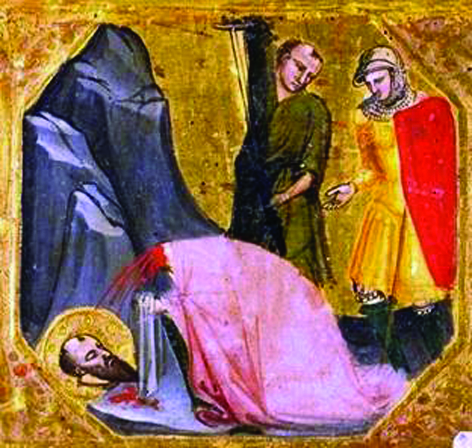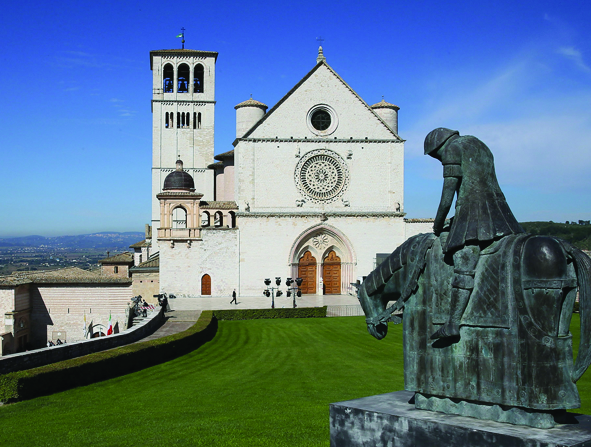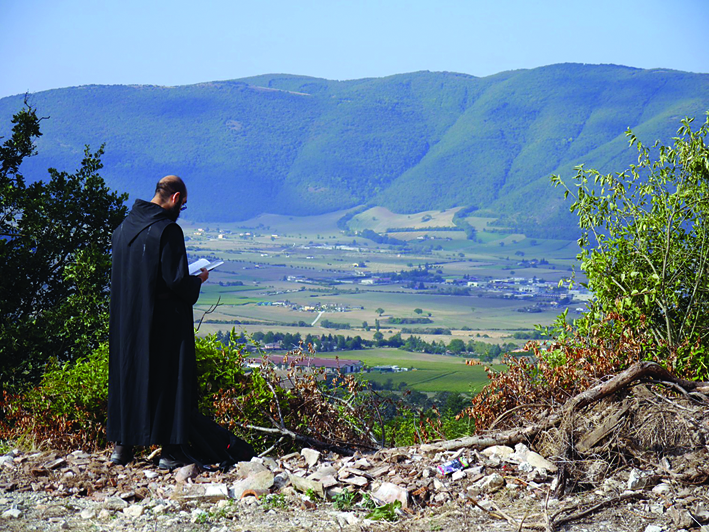Pilgrimage destinations in the heart of the Church
By Christina Deardurff
 History tells us that at the time of St. Paul’s martyrdom in the first century, Roman law prevented any Roman citizen from being put to death through the ignominious method of crucifixion.
History tells us that at the time of St. Paul’s martyrdom in the first century, Roman law prevented any Roman citizen from being put to death through the ignominious method of crucifixion.
Tradition tells us that St. Paul, a Roman citizen, was therefore beheaded instead, while chained to a marble column in Rome – and his severed head bounced three times before coming to rest. The spots where St. Paul’s head is said to have bounced are the locations of three separate springs of water, called afterward “Tre Fontane”—“Three Fountains.”
One of Rome’s earliest churches, Chiesa del Martirio di San Paolo alle Tre Fontane, or Church of the Martyrdom of St. Paul of the Three Fountains, stands at the site. It was built in the 16th century, but the original church was built in the 5th century—just a few hundred years after his death.
Visitors to the Tre Fontane were once able to take bottles of the water issuing from the fountains; due to pollution, that is no longer possible. But what is possible, with a little luck and experience, is gaining access to the marble column; a select few are given the rare opportunity to venerate this holy relic of the “Apostle to the Gentiles,” to whom Christ once spoke those heart-piercing words, “Quo vadis?”
Nearby is the home of St. Pudens, mentioned in the Bible by St. Paul; the first papal residence, it housed St. Peter himself for seven years. Visitors who know the “gatekeeper” can access the oldest part of the building, dating to the first century.
 Another awe-inspiring destination not too far from Rome is the tiny town of Manoppello, and the incredible, perhaps supernatural, portrait of a Man – some say He is the Man of Sorrows – which resides there in a small church. His face appears on a “canvas” made of byssus, a material woven from the beards of sea mussels – and its origin is inexplicable in purely human terms.
Another awe-inspiring destination not too far from Rome is the tiny town of Manoppello, and the incredible, perhaps supernatural, portrait of a Man – some say He is the Man of Sorrows – which resides there in a small church. His face appears on a “canvas” made of byssus, a material woven from the beards of sea mussels – and its origin is inexplicable in purely human terms.
Pilgrims to the Shrine of Manoppello stare in wonder at this visible sign and find in the Man’s eyes a look of love and mercy that draws them closer to Him.
Then there is Assisi, the charming town which was the home of St. Francis, “Il Poverello.” Not only is it the site of a beautiful shrine and churches dedicated to both St. Francis and his dear friend St. Clare, but it is also the resting place of Blessed Carlo Acutis. Carlo is the 21st-century teenager (he died in 2006) who catalogued the world’s Eucharistic miracles online. Pope Francis beatified him just last year.
 Perhaps most naturally spectacular is Norcia – ancient, lovely Norcia, with its breathtaking views of the adjacent Sybilline Mountains, its vestiges of first-century Roman architecture, its 16th-century churches and buildings, and of course, the enduring presence of St. Benedict, its famous native son. The Benedictine ideals that informed all subsequent monasticism in the Western Church were nurtured here. They remain alive in Norcia, at the Benedictine monastery that was re-founded by the American priest Cassian Folsom in 1998. It was built again nearby after a devastating 2016 earthquake destroyed the Church of St. Benedict and much of the monastery in the city center.
Perhaps most naturally spectacular is Norcia – ancient, lovely Norcia, with its breathtaking views of the adjacent Sybilline Mountains, its vestiges of first-century Roman architecture, its 16th-century churches and buildings, and of course, the enduring presence of St. Benedict, its famous native son. The Benedictine ideals that informed all subsequent monasticism in the Western Church were nurtured here. They remain alive in Norcia, at the Benedictine monastery that was re-founded by the American priest Cassian Folsom in 1998. It was built again nearby after a devastating 2016 earthquake destroyed the Church of St. Benedict and much of the monastery in the city center.
Fr. Cassian, though retired from his role as Prior of the monastery, still gives spiritual talks to visitors and speaks about St. Benedict and the Benedictine life to which he is dedicated.
Few pilgrims to Norcia leave unmoved after hearing his testimony of faith.
 These holy and beautiful places and the people associated with them – whom we call the “living stones” of the Church – are all part of Inside the Vatican Pilgrimages’ upcoming “Journey Toward the Face of Christ” pilgrimage May 28-June7, 2022. Setting out on pilgrimage is a time-honored and sacred tradition. Like the pilgrims of old, we invite you to join us on this journey of spiritual renewal – a “Journey Toward the Face of Christ.”
These holy and beautiful places and the people associated with them – whom we call the “living stones” of the Church – are all part of Inside the Vatican Pilgrimages’ upcoming “Journey Toward the Face of Christ” pilgrimage May 28-June7, 2022. Setting out on pilgrimage is a time-honored and sacred tradition. Like the pilgrims of old, we invite you to join us on this journey of spiritual renewal – a “Journey Toward the Face of Christ.”






Facebook Comments